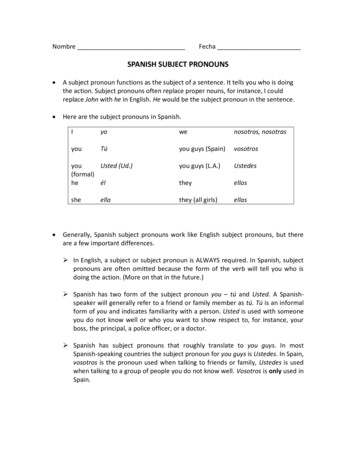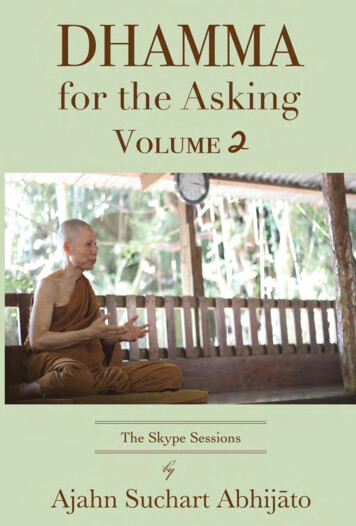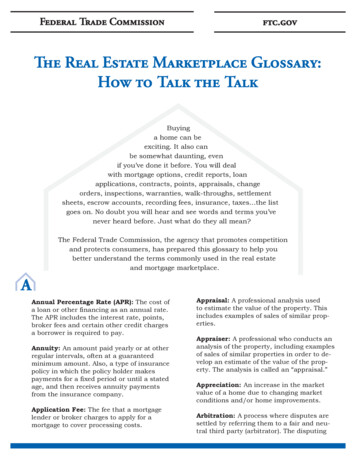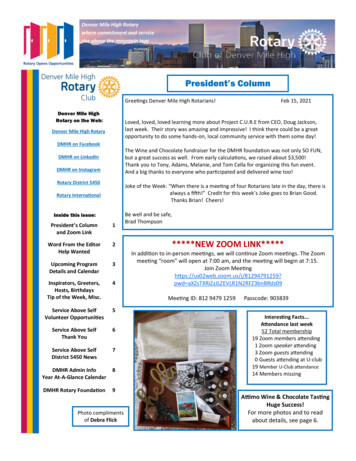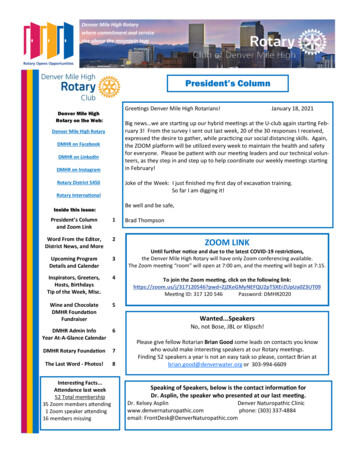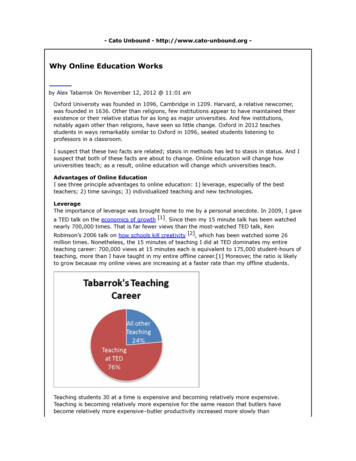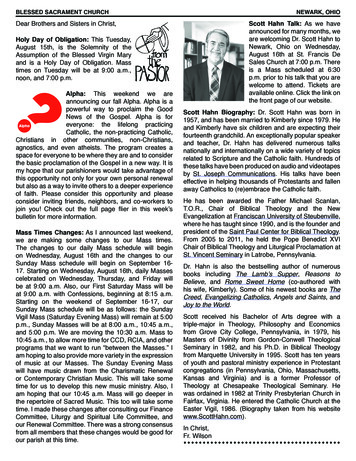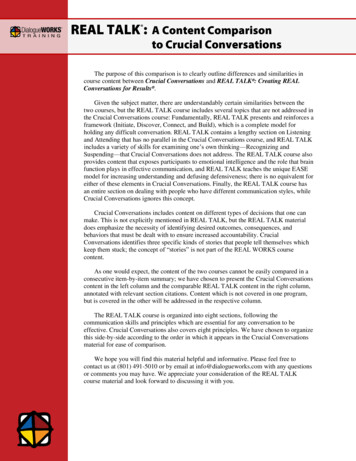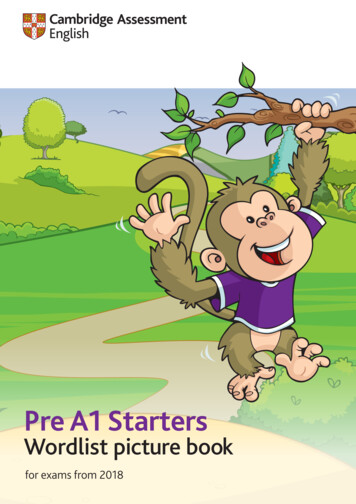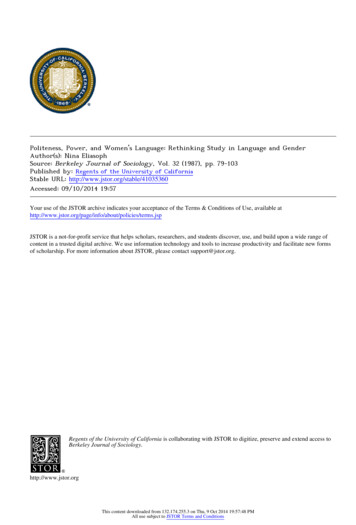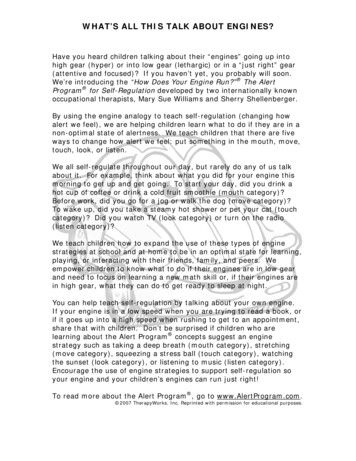
Transcription
WHAT’S ALL THIS TALK ABOUT ENGINES?Have you heard children talking about their “engines” going up intohigh gear (hyper) or into low gear (lethargic) or in a “just right” gear(attentive and focused)? If you haven’t yet, you probably will soon.We’re introducing the “How Does Your Engine Run?” The AlertProgram for Self-Regulation developed by two internationally knownoccupational therapists, Mary Sue Williams and Sherry Shellenberger.By using the engine analogy to teach self-regulation (changing howalert we feel), we are helping children learn what to do if they are in anon-optimal state of alertness. We teach children that there are fiveways to change how alert we feel: put something in the mouth, move,touch, look, or listen.We all self-regulate throughout our day, but rarely do any of us talkabout it. For example, think about what you did for your engine thismorning to get up and get going. To start your day, did you drink ahot cup of coffee or drink a cold fruit smoothie (mouth category)?Before work, did you go for a jog or walk the dog (move category)?To wake up, did you take a steamy hot shower or pet your cat (touchcategory)? Did you watch TV (look category) or turn on the radio(listen category)?We teach children how to expand the use of these types of enginestrategies at school and at home to be in an optimal state for learning,playing, or interacting with their friends, family, and peers. Weempower children to know what to do if their engines are in low gearand need to focus on learning a new math skill or, if their engines arein high gear, what they can do to get ready to sleep at night.You can help teach self-regulation by talking about your own engine.If your engine is in a low speed when you are trying to read a book, orif it goes up into a high speed when rushing to get to an appointment,share that with children. Don’t be surprised if children who arelearning about the Alert Program concepts suggest an enginestrategy such as taking a deep breath (mouth category), stretching(move category), squeezing a stress ball (touch category), watchingthe sunset (look category), or listening to music (listen category).Encourage the use of engine strategies to support self-regulation soyour engine and your children’s engines can run just right!To read more about the Alert Program , go to www.AlertProgram.com. 2007 TherapyWorks, Inc. Reprinted with permission for educational purposes.
How Does Your Engine RunHeather Childs, Registered Psychologist #809Feb 5, 2012How Does Your Engine Run? (Alert Program)Primary Focus - to help children learn to monitor, maintain, and change their level of alertnessso that it is appropriate to a situation or taskDesigned to: Help recognize arousal states as they relate to attention, learning, and behavior Help to expand the number of self-regulation strategies student’s use in a variety of tasksand settings.Arousal – describes how alert one feels. In order to attend, concentrate, and perform tasks in amanner suitable to the demand of the situation. In this program the word “alert” is used in placeof “arousal.”Self-regulation – the ability to attain, maintain, and change arousal appropriately for a task orsituation.Q- Why does movement help you calm down?Involves thinking andreasoningTakes information frommuscles and joints(proprioceptive system)Contains thereticular formation,responsible for howalert we feel1
Top down inhibition – using one’s thinking process to regulate oneself. Ex. Mary might talk to herself to stay on task and remind herself of the consequence ifshe does not complete her work. From the top of her brain and down, she is trying to inhibit herself. This is not efficient. It’s like Bottom- up inhibition – using muscles and movement to regulate oneself The brain is responding to input from the body and regulating itself naturally. This helps the student’s nervous system to function optimally It’s like Q- Why does a child need to have so many breaks – they can’t do this as an adult.A child’s nervous system may crave movement, for example, swinging.In a certain developmental period, a child may choose to swing at every school recess(frequency), pumping as hard and as fast as possible (intensity). The child may continueswinging the whole recess period (duration).The adults nervous system may enjoy swinging but only seeks light swinging movements(intensity) for short periods of time (duration), once in a great while (frequency).Most adult nervous systems do not need as much intensity, frequency, or duration ofsensorimotor input to reach or maintain optimal functioning (arousal) appropriate for a specifictask or situation.Program Overviewo Program has 3 Stageso Each stage has a varied number of Mile Markers (objectives)o Each Mile Marker has a varied number of activities (lessons to teach objectives)Designed for grades 4-8 but can be adapted for other grades (See Chapter 5 for adaptations)NOTE: Those who are younger than 8 years or are developmentally delayed may not havethe self-knowledge to complete the 3rd stage and select strategies independently2
Stage 1: Identifying Engine SpeedsMile Marker 1: Students learn the engine wordsMile Marker 2: Adults label their own engine levelsMile Marker 3: Students develop awareness of the feel of their own engine speeds,using the adults’ labels as guidesMile Marker 4: Students learn to identify and label levels for themselvesMile Marker 5: Students label levels for themselves, outside the teaching moment3
Stage 2: Experimenting with Methods to Change Engine SpeedsMile Marker 6: Leaders introduce sensorimotor methods to change engine levelsMile Marker 7: Leaders identify sensorimotor preferences and sensoryhypersensitivitiesMile Marker 8: Students begin experimentation with choosing strategiesWhen you need to concentrate at your work space, what helps you to work mostefficiently?Tools for the mouth:Oral motor input has a range of characteristics, including the following:a) Action Variables (what you do):- blowing, sucking, swallowing, biting, crunching, chewing, lickingb) Quality Variable (how it feels or tastes):- physical feeling of resistance when biting, crunching, chewing, sucking,blowing; the taste of sour, sweet, salty, spicy, or bitter; the temperature of foodsuch as hot chocolate, cold popsicle, or warm soupc) Medium Variables (with what?):- whistle, straw, bubbles, musical instrument, exercise water bottle, candy, beefjerky, rubber tubing, fruit, crackers, pretzels, gum, bagels, popcorn, etc.Tools for the BodyVestibular and proprioceptive (information from muscles) inputs include:(Note: these are all in relation the direction that one’s head goes in. For example,bouncing a ball would be an example of heavy work, rather than an “up and down”motion that one would think).a) Oscillation (up and down):- sitting on a teeter-totter, trotting on a horse, jumping, sitting and bouncing on atherapy ball, or jumping on a trampolineb) Linear (front and back):- swinging on a playground swing, rocking in a rocking chair or on a rockinghorse, or swinging on a gliderc) Rotary (circles):4
- riding on a merry-go-round, using a “sit ‘n spin”, standing and twirling, orspinning on a tire swingd) Inverted (upside down):- hanging by the knees on a playground bar with hands near the ground, bendingover with head between knees, “wheelbarrow” walking, or on tummy laying overtherapy balle) One type of proprioception (heavy work) meaning input to muscles, tendons, andjoints:- crossing the monkey bars on a playground, climbing a tree, pushing furniture,lifting firewood, or pulling a sled uphillf) Another type of proprioception (crash and bump):- jumping into a large pile of pillows, doing a “cannon ball” off the diving board,tackling a player in football, or driving bumper carsHeavy Work5
Tools for the eyesVisual input can include:a) Variations in light:- natural lighting vs. artificial lighting,- dim lighting vs. bright lightingb) Variations in colour:- walls painted a neutral colour vs. a bright colour,- classroom bulletin boards decorated with muted brown, beige, &/or rose vs. abrilliant red, orange, or yellow colourc) Variations in the amount of visual distractions- sparsely decorated room vs. visually cluttered room6
Tools for the earsAuditory input can include:a) Variations in noise level- quiet music vs. loud music,- whispering vs. screamingb) Variations in rhythm- slow music vs. fast- rhythmical music vs. a-rhythmicalc) Variations in amount of auditory distractions- quiet working environment vs. noisy working environment,- constant background noise (such as a clock ticking) vs. unexpected soundsStage 3: Regulating Engine SpeedsMile Marker 9: Students choose strategies independentlyMile Marker 10: Students use strategies independentlyMile Marker 11: Students learn to change engine levels when options are limitedMile Marker 12: Students continue receiving support7
How Does Your Engine Run Program OverviewStages/Mile Markers/Activities Overview/Activity p. # Printable p. #Stage 1: Identifying Engine SpeedsDiscussions 1-3 minutesMile Marker 1: Students learn the4-3engine level wordsa) Our Engine Speeds (3-10 min.)4-3b) Engine Speeds Guessing Game4-4c) Engine Collage4-4Mile Marker 2: Adults label their own 4-5engines (No activity, provide infobefore, during & after session).DescriptionUse the 3 activities to define engine vocabulary. “If your body is likea car engine, sometimes it runs on low, sometimes on high, orsometimes just right.” Show what an engine in high, low, and justright might feel like.A-4 to A-6, Engines Use pictures to demonstrate what people look like at high, low, andin high, low, and just just right levels. Place them on corresponding charts.rightA-4 to A-6, Engines Use same enlarged pictures and have a guessing game – is the personin high, low, and just high, low, or just right? Tell a story about each picture to helprightstudents fully understand what indicates the level. E.g. show thepicture of the boy sitting at his desk, and explain that the boy isfeeling great. He’s finding it easy to pay attention and to get his workdone. He’s not overexcited. He’s not feeling like a couch potato. He’sin ** gear.A-4 to A-6, Engines Make collages. End session with: “We sure had fun playing togetherin high, low, and just today. We learned that if our body is like a car engine, our enginesrightcan run on high, low, or just right. We’ll talk more about our enginespeeds tomorrow.”NO ACTIVITYAdults use the engine terms in regular conversation by labeling theirengines frequently. “My engine is too high, I need to go for a walkduring recess to get to that just right level to teach.”1
Mile Marker 3: Students developawareness of the feel or their ownengine speeds, using the adults’ labelas guides4-5--a) Obstacle Course4-3-b) Stations4-6-Set up obstacle course in large open space. May include: crawlingthrough cloth tunnel, bouncing on therapy ball, rolling onscooterboard, crawling under landing mat, blowing cotton ball usingstraw across a track.Comment on their engine levels as they are doing the obstacle course.Add motivators if necessary, use a stop watch, do it one-at-a time,aim to beat the group time, etc.Set up 2-6 stations, students play at each station for 5-15 minutes,label the students engines while they are playing at each station.Continue with obstacle courses, but teach students how to monitortheir own alertness levels.Mile Marker 4: Students learn to4-6identify and label levels for themselvesEach activity from this point forward should follow this sequence:1. Chart level of alertness on High-Low Chart2. Engage in gross motor movement to obtain optimal arousal state (e.g. obstacle course, movement stations, etc.)3. Chart level of alertness following movement.4. Introduce Mile marker activity or discussion selected for the particular session. While leader conducts a discussion or activity,students should use previously learned strategies to stay at the “just right level”5. Leader and student together assure that the student’s engine is just right as the session closes6. Leader briefly summarizes the concept that was introduced in that session.a) Engine Speedometer4-7Students make engine speedometers to use in different settings (atleast one to be taped or used at their desk. See page 4-7 forexamples.Mile Marker 5: Students label levels4-8for themselves, outside of sessionsa) How Does Your Engine Run?4-8A-7 to A-10, HowStudents use the activity chart to label their alertness levels at homeDoes Your Engineand throughout their school day.Run charts2
Stage 2: Experimenting withMethods to Change Engine SpeedsDiscussions 5-10 minutesMile Marker 6: Leaders introducesensorimotor methods to changeengine levels4-9-a) Engine Tune-Up: Tools For TheMouth4-94-10b) Engine Tune-Up: Tools For TheBody4-12A-11 to A-20, Waysto Move picturesc) Engine Tune-Up: Tools For TheHands4-13-3Review Mile Marker 7 before completing this activity. By the end ofthis Mile Marker, students will learn 5 ways to change how alertthey feel: through oral, movement, touch, looking, or listening. SEEp. 2-9 for a review of these strategies.Use the chart on p. 4-10 in a large format. Explain that you can trydifferent things to change your engine speed. One way is to putthings in your mouth to help their engines change. Review the wordson the chart. Have a collection of items to sample (p. 4-9).Studentstake turns picking one item from the container and determiningwhere to mark the item on the grid. E.g., lollipop – sweet, licking,sucking. Then give the item to all students to try and discuss.Continue for all items and discuss other items that are not beingsampled. Do not ask the students what helps their engines change. Atthis point, it’s only an introduction. The adult should talk only abouthis/her own engine.Similar to above activity but using movement rather than things formouth. Remind students of oral strategies that helped them the lasttime. Use these while you discuss the activity. Discuss ways tomove: front and back, up and down, circles, crash and bump, upsidedown, and heavy work (muscles). Use pictures to identify what typeof movement is being done and tape them under categories on theboard. Movements are described in relation to how one’s head ismoving.Cover table with newspaper, use items on p.4-13 to explore howtouch changes their engine levels. During the discussion, havestudents use tools for the body to help them stay engaged (therapyball, t-stool, etc.). students will make flour balloon fidgets in thisactivity. Offer other fidgets for them to try as well. If s puts theballoon in their mouth, direct them to a strategy appropriate for oralmotor input.
d) Engine Tune-Up: Tools For TheEyes4-14-Use previously learned strategies during discussion. Discuss howlighting and colour can change your engine levels. Tour the buildingand point out different rooms with variation of visual input OR usepictures and discuss visual impact of each. Adult to discuss theirown engine preferences. Don’t ask students at this point about theirown preferences – but do point out what you see to help themunderstand what is working for them.Use previous strategies to keep engines “just right” duringdiscussion. Play music in background while students do an activity.Music should alternate between types, rhythms, etc. Discuss whatstudents could do to problem solve in situations such as one personneeding noise and another needing quiet, etc.Adult comments on what strategies seem to be helping students.E.g., “Liz, when you filled out the chart today, your engine wasrunning in low speed. Jumping up and down on the trampolineseemed to help your engine get to a just right speed.”e) Engine Tune-Up: Tools For TheEars4-15-Mile Marker 7: Leaders identifysensorimotor preferences and sensoryhypersensitivities(No activity, provide info before,during & after session).Mile Marker 8: Students beginexperimentation with choosingstrategiesa) Sorting Engine Tools4-16NO ACTIVITY4-17--4-17A-21 to A-39, Cardsfor the Mouth, Body,Hands, Eyes, Earsb) Variation Of Sorting EngineTools4-18A-21 to A-39, Cardsfor the Mouth, Body,Hands, Eyes, EarsSet up obstacle course stations. Do the activity, pick a picture cardand place it under the correct heading (cards for mouth, body, hands,eyes, ears). At the end, review, and have students fill in blank cardswith other ways to change their engine levels – putting them underthe correct headings.Use same cards as above. Make a stack of cards for each student.Have each student do an obstacle course activity, and at end pick acard, decide if it is a preference for them, and place on a larger paperwith their name on it. Have them fill out blank cards with other ideasthat they prefer.4
Stage 3: Regulating Engine SpeedsDiscussions 5 minutesMile Marker 9: Students Choosestrategies independentlyc) Customizing Engine Care4-18-4-19d) Changing How Alert You Feel4-20A-40 to A-44, Putsomething in yourmouth etc.; A-21 toA-26, Cards formouth etc.A-45 to A-46,Changing How AlertYou Feel formsMile Marker 10: Students usestrategies independently, outsidetherapy sessionsa) Sharing Stories From Home AndSchool4-20-4-20-b) Can You Change Your EngineSpeed4-21A-47, Can youchange your enginespeed chartc) What Works, What Bothers Me?4-22A-48 to A-50, Whatworks, What bothersme? 3-page chartd) Fanny Pack Game4-23A-51; A-21 to A-39Cards for the Mouth,Body, Hands, Eyes,Ears5Expect that students will start choosing their own strategies. Giveplenty of positive feedback when you see them using a strategy.Copy the picture of the large mouth for each student. Pick up smallpictures of oral strategies. Individually, each student decided if thatstrategy helps them and glues or draws it on their page. This can bedone for all 5 ways as well.Print out the alert form for each student. This reviews what the Alertprogram is about – ask students to take them home and discuss itwith their parents. Have students highlight their own preferences onthe form.In advance ask students to pay attention to their engine outside ofschool.Then encourage them to share stories at the next session. Tell astory, write a story, or draw a picture. Continue providing strategiesto be used during discussions and activities.Use a chart to monitor how their engines change after using astrategy. Charts should be individualized to the student. Fill in thechart at home. In the next session, discuss experiences about fillingout the chart. Continue adding to the chart and re-using it toencourage carry-over of the engine concepts.Use that what works, what bothers me chart – give one to eachstudent. Discuss strategies and have each student put the item on thechart in the correct location as it relates to them. Use the discussionto help problem solve as some of the strategies may not always beavailable or they may not be allowed to use them all of the time.Help students learn to plan ahead to use things that change theirengine levels. They think of items to take to school, for the car, instores, etc. In each setting, use cut out pictures and have studentsplace them in a picture of a backpack, purse, or fanny pack.
Mile Marker 11: Students learn tochange engine levels when options arelimiteda) Maintenance Required: AProblem- solving Game4-24-4-24A-52 to A56;Problem SolvingQuestionsA-55; Sensory-MotorPreference Checklistb) Sensory-Motor PreferenceChecklist Interviews4-24Mile Marker 12: Students continuereceiving support4-25-6Use sample problem questions to practice problem solving. Eachstudent gets a question, problem solves, and others can add theirthoughts.2 sessions. 1) Give each student a sensory-motor preferencechecklist to take home and interview their parents, friends, etc.Practice interviewing in class first. 2)At the next session review theexperience with students – comment on how different the strategiesare that people need to keep themselves “just right.”Follow up periodically, perhaps monthly, then every other month,and every six months.
Heather JeancartRegistered Psychologist #809Nov. 28, 2011Body Breaks(Individual students or class-wide)Include the following elements, in this order:1. Lots of movement and jumping to begin. Activities like jumping jacks, pretend downhillskiing, etc. are excellent choices.2. Then progress to movement without jumping (e.g. miming swimming strokes). Ensureboth sides of the body are working.3. Then play the “grown-up” version of Simon Says, where students simply copy posturesrather than listening to Simon’s instructions.a. Begin with the arms moving one at a time. (e.g. right hand on right shoulder andleft hand on left shoulder).b. Then progress to having the arms cross the midline, but doing the same thing,(e.g. moving hands to opposite shoulders).c. Finally, end with arms moving together, crossing midline, but doing differentthings (e.g. right arm on left shoulder, left arm on right knee)This progression moves from simple to complicated movement patterns, and “slowsdown” the students by making them think about their movements.4. Have the students sit down and perform a chair push-up or do a seated heavy workactivity.5. Finish the body break by using both index fingers and pointing to various facial features,labeling the movements in a soft voice (“touch your mouth, touch your ears,” etc.).Continue until all students are “with you” then announce, “Everyone looks ready forlearning.”The important part of a body break is that it moves through the 5 identified stages (jumping,movement without jumping, moving so students need to think about the body, heavy work,and a soft, seated re-focusing activity). This will help regulate students.Example:1. Let’s do jumping jacks2. Now we’re downhill skiing (in a squat position)3. Let’s swim - Ensure both sides of the body are working while doing swim strokes.4. Put your right hand on right shoulder and left hand on left shoulder. Begin with the armsmoving one at a time.5. Now your right hand is on your left shoulder, left hand on right – one at a time.6. Move arms together right arm on left shoulder, left arm on right knee (and vice versa). Thisprogression moves from simple to complicated movement patterns, and “slows down” thestudents by making them think about their movements.7. Sit down, put your palms together, and use all your strength to push your arms together.8. With a soft voice – now touch your mouth, touch your ears, touch your eyes, touch your nose.Etc. Continue until all students are “with you” then announce, “Everyone looks ready forlearning.”
learning about the Alert Program concepts suggest an engine strategy such as taking a deep breath (mouth category), stretching (move category), squeezing a stress ball (touch category), watching the sunset (look category), or listening to music (listen category). Encourage t
